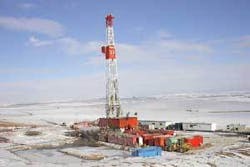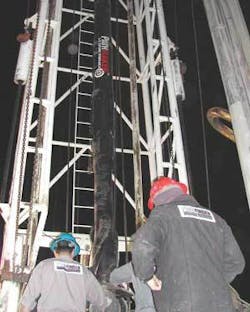Deeper wells, higher heat, pressure gradients and more horizontal well paths merits MWD-LWD tools with staying power, says Pathfinder
As with its existing array of MWD-LWD, directional drilling and formation evaluation equipment, Houston-based PathFinder Energy Services is directing specific market focus at the high pressure, high temperature (HPHT) downhole environment of wells in geographical regions with steeper geopressure/geothermal gradients.
The company emphasizes its smaller-diameter tool systems for such boreholes, as well.
“We’re concentrating on the deep, hot Wilcox-type development, whether it’s Offshore, South Texas or in the Middle East or anywhere else that exhibits hot, highly pressured geology,” said Ron Weegman, PathFinder’s Global Technology Support Manager.
Chief among the company’s “hot” borehole MWD-LWD services these days is the relatively new Survivor suite of tools.
At the core of this emerging complement of HPHT tools is the Survivor HDS-1L fixed-collar directional service, using positive-pulse telemetry for real-time communication for continuous inclination and azimuth data. The newest iteration of Pathfinder’s time-tested HDS-1 tool, the 1L is equipped with an integral vibration sensor, high lost-circulation material (LCM) tolerances, and low pressure drop. The tool also contains the Data-Link interface for two-way telemetry with MWD-LWD sensors.
More Survivors™
Working along with the HDS-1L are additional Survivor systems introduced for commercial application: The Survivor Array Wave Resistivity (AWR), the Survivor Slim Array Wave Resistivity (SAWR), the Survivor Dynamic Pressure Module (DPM) and the Survivor Slim Density Neutron Standoff Caliper tools.
The Survivor AWR and SAWR tools are a fully compensated, dual frequency tools with 12 diameters of investigation from three sensors at a spacing of 15, 25 and 45 inches along the tool face to provide quantitative data for formation evaluation. This includes advanced processing of anisotropic and dielectric effects, invasion analysis and thin-bed modeling.
The Survivor DPM tool uses two independent quartz gauge transducers to measure drill pipe and annulus pressures and temperatures.
The Survivor Density Neutron Standoff caliper tool provides real-time bulk density, neutron porosity, photoelectric index, standoff and caliper measurements in hostile environments and in hole sizes as small as 57⁄8 inches while drilling. Batteries are rig site replaceable.
According to PathFinder, the caliper tool is the first in the LWD industry to use Californium-252 as its neutron measurement source. The Californium-252 chemical source has lower energy and a shorter half-life profile, making it more environmentally friendly.
Like the other Survivor services, the caliper tool is capable of operating for extended periods at pressures of up to 25,000 psi in static bottom-hole temperatures of up to 350 degrees F (175 degrees C).
Additionally, the modular design of all Survivor services allows tool stacking in any order on the BHA to meet specific job requirements.
Formation pressure testing vigorous, too
Like many of its competitors, Pathfinder also is marketing its version of an LWD formation testing service. The company’s Drilling Formation Tester (DFT) was introduced commercially in 2004. The system so far has been deployed successfully in the U.S. and in northwestern Europe.
The DFT tool recently was included in the BHA for a directionally drilled 8½-inch hole section in a well located in the UK North Sea on a semisubmersible rig. The tool was used to perform a total of 12 formation pressure tests during a single bit run. All of the tests were successful, including an added repeat test.
Unconventional gas markets
Hand-in-hand with Pathfinder’s HPHT market thrust is its close attention to several of the unconventional gas markets, including coalbed methane development everywhere and drilling in tightly bedded shales with severe hole failure potential, such as the Barnett and Fredericksburg Formations, among others in the U.S. and similar shale-based formations elsewhere in the world.
In either case, the preponderance of boreholes drilled is horizontal in nature, calling for rotary steerable drilling systems and the MWD-LWD equipment to go with it.
A huge market is developing in coalbed methane alone. Rigs are small, but 6½-inch holes are pretty common. However, smaller holes also are being drilled in coalbed methane development, making the company’s 31⁄8-inch tools applicable.
For drilling conventional oil and gas wells, Pathfinder is currently developing azimuthal gamma ray and density tools for wellbore imaging, coupling them with its PathMaker® 3-D Rotary Steerable System (3DRS) for horizontal sections. Such imaging has become a navigational tool for operators, since matching the LWD response with geological earth models allows them to alter the model with important data like formation dip and faulting, which makes it possible to steer more precisely in pay zones.
Good times now, also ahead
Currently and for the foreseeable future, MWD-LWD technology will continue to play a much larger role on all drilling fronts, said Weegman.
Drilling activity is such that operators are using logging while-drilling tools in instances where, in a less robust market, they might have used wireline tools, he said. Also, there are more and more horizontal well paths these days, and drill pipe-conveyed logs and various tractor devices ultimately are expensive. So, Weegman noted, such market conditions make the decision to apply MWD-LWD more feasible, and economical.





